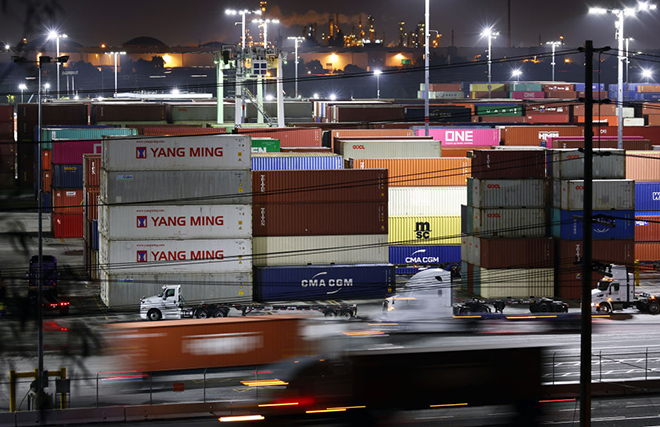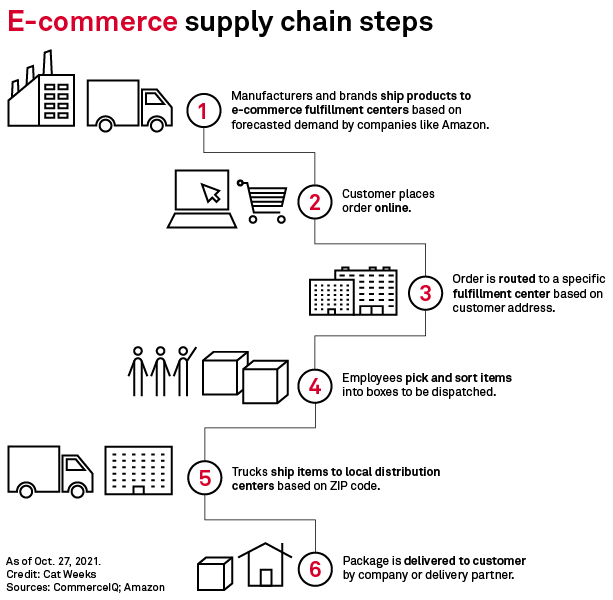S&P Global Offerings
Featured Topics
Featured Products
Events
S&P Global Offerings
Featured Topics
Featured Products
Events
S&P Global Offerings
Featured Topics
Featured Products
Events
Banking & Capital Markets
Economy & Finance
Energy Transition & Sustainability
Technology & Innovation
Podcasts & Newsletters
Banking & Capital Markets
Economy & Finance
Energy Transition & Sustainability
Technology & Innovation
Podcasts & Newsletters
S&P Global Offerings
Featured Topics
Featured Products
Events
2 Nov, 2021

Trucks haul shipping containers at the Port of Los Angeles during nighttime operations Oct. 25.
Persistent supply chain constraints are expected to have an uneven impact on e-commerce this holiday season, with Amazon.com Inc. and other large retailers better positioned to meet demand than smaller merchants, retail experts say.
Strong consumer demand for goods is hitting up against pandemic-related labor disruptions to manufacturing and shipping, creating product shortages on some store shelves. But Amazon and other large retail buyers can command better pricing for bulk orders and own some of their own transportation infrastructure, leaving smaller sellers and independent businesses competing for more limited inventory and shipping resources.
"Amazon and large players like Walmart Inc. and Target Corp. are going to be much better positioned to use their clout and their negotiating sway to get first pick for a lot of items," said Tim Campbell, director of industry insights at CommerceIQ, an e-commerce management platform based in Palo Alto, Calif. "A lot of the smaller regional players are going to get whatever is leftover."
According to the National Retail Federation, online and other non-store holiday sales are set to jump between 11% and 15% year over year this November and December to a total of between $218.3 billion and $226.2 billion. High savings rates and rising incomes have put consumers in a position to spend this holiday season, despite rising inflation, said Matthew Shay, CEO of NRF.
Meanwhile, U.S. imports have risen to record highs. U.S. imports of leisure items including toys climbed 9% in September year over year, while imports for apparel and textiles grew 7.8%, according to Panjiva, a business line of S&P Global Market Intelligence.
Notably, consumer electronics is not seeing the same bump, largely due to persistent shortages of semiconductors that worsened during the pandemic, said Eric Oak, research analyst with Panjiva. Imports of consumer electronics such as iPhones dipped 6.5% year over year in September.
A head start
Many large retailers were able to foresee bottlenecks months ago and stockpile earlier in the season, said Michael Baker, manager director at investment banking firm D.A. Davidson. They also have the wherewithal to quickly scale logistics operations.
Companies like Costco Wholesale Corp. and Walmart are chartering their own container vessels to help expedite shipments from overseas. A Walmart spokesperson pointed to several other initiatives designed to help the company navigate supply chain constraints, including hiring 20,000 new employees and adding storage capacity to its fulfillment and distribution network.
Walmart can also operate its own fleet of trucks and leverage its network of 10,500 stores and clubs to act as mini distribution centers for e-commerce orders.
"Having the product that much closer to the customer lets Walmart deliver more cost-effectively," Baker said. "You're driving less and you're likely to have the product in stock closer to the consumer."
Amazon declined to discuss whether it was chartering container vessels but noted in an Oct. 25 blog post that it has doubled its container processing capacity and expanded its ocean freight carrier partnerships. Amazon is also armed with more than 800 delivery stations globally, along with its own network of fulfillment centers and more than 50,000 trailers that haul freight across the world. It expanded its Amazon Air cargo fleet and will have more than 85 aircrafts later this season.
Supply chain complexities
Still, any backlogs within the e-commerce supply chain could cause a series of disruptions that make it difficult to get goods delivered on time no matter how efficient a company's system runs, said Campbell, of CommerceIQ.
That became evident early in the pandemic, when a surge in demand for goods including electronics and appliances led to backlogs in delivery. Labor shortages exacerbated the problem. The U.S. Labor Department in its most recent employment data release found that as of late August, there were 10.4 million open positions across industries, including about 1.2 million in retail.
Big businesses like Amazon use technology to forecast demand patterns by ZIP code for tens of thousands of goods, but "an error at any point can cause delays throughout the next steps," Campbell said. "The further back it goes in the supply chain, the bigger combined effect it has."

A lack of workers in a specific fulfillment center can delay an order by several days, while a dearth of cargo employees to unload shipping containers can create a much longer delay of weeks or months. A factory closure, due to COVID-19 or other disruptions, could limit manufacturing, fueling even longer delays and shortages for popular products.
"In that case, everyone is kind of in the same boat together," Campbell said.
Higher costs
Small businesses, meanwhile, face their own unique supply chain challenges.
Some Amazon third-party sellers are facing storage limitations within Amazon fulfillment centers, leaving merchants scrambling to find alternate facilities and logistics providers, said Kunal Chopra, CEO of Kaspien, a Spokane, Wash., third-party Amazon seller that also helps other brands sell on Amazon.com and other marketplaces.
Shipping independently is not nearly as efficient as sending products through Amazon's fulfillment network, which can deliver goods to consumers' doorstep within one or two days. Third-party sellers that ship products through alternate means will see products arrive closer to a five- or six-day window, Chopra said. While most customers understand the delays, especially for bulky and oversized items like strollers and furniture, it creates more expenses for sellers.
"We've got to add more workers, more warehouse space, we've got to scale our operations," Chopra said. "All this adds cost."

